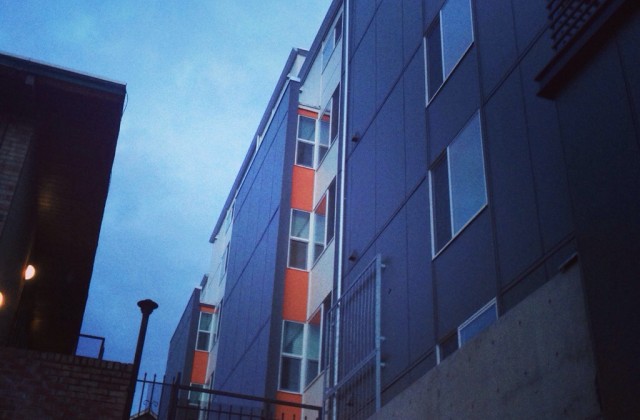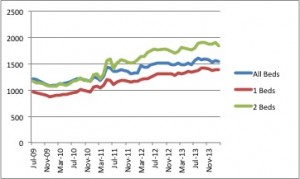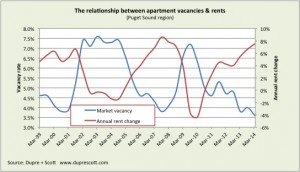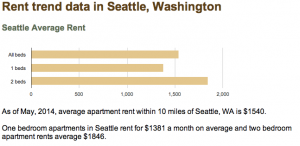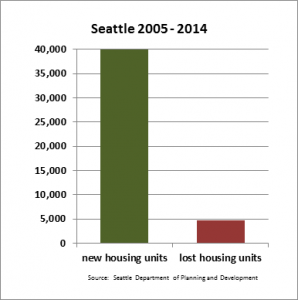Can’t We All Just Get Along: Common Ground with Non-Profit Developers
I was given the opportunity this week to present to the board of the Capitol Hill Housing Improvement Program (CHHIP). CHHIP has been a leader in building affordable housing in Seattle for many years. In fact, the first person I met with when urging new development in the South Park neighborhood back in the 90s was Chuck Weinstock who was, at the time, the Executive Director of CHHIP. Even though we were on the other side of town, Weinstock and CHHIP we considered the best place to start when considering affordable housing development.
CHHIP has a different leader now, Chris Persons, who has great experience and dedication to the field as well. So I was honored and pleased when he asked to talk with his board about incentive zoning. This is a tough subject, because we don’t think incentive zoning is an incentive at all; in fact, we think incentive zoning is actually contributing to Seattle’s housing problems by putting an inhibitive tax on new housing instead of actually encouraging more housing. But CHHIPs board has an open mind on the subject, or at least open minded enough to let me speak with them.
My take away point, at the end, is that non-profit and for-profit developers have much more in common than might appear on the surface. Both non-profit and for profit developers face land use regulations, design review, utility hook up issues, challenges with surrounding neighbors, and land and construction costs. It isn’t easy to build affordable housing in Seattle whether the developer is a non-profit trying to build artist live work space or a for profit developer trying to build mid or high rise. I am hoping that we can find more of that common ground, even while we disagree about incentive zoning. When it comes to building housing regulated by a City that sometimes has more rules than ideas, we’re all in this together.
Here’s the points I made in the presentation including the familiar Power Point slides we used earlier this year.
Presentation on Incentive Zoning to Capitol Hill Housing Improvement Program
June 9, 2014
Introduction
Seattle has a tendency when it sees a problem, to try to solve that problem with rules, programs, and regulatory interventions. We’re very good at using the lead end of the pencil, but we haven’t learned to use the eraser end yet.We know that any encumbrance we put on land and its use can
- Lower it’s value;
- Increase costs to build on it;
- Impact risk; and
- Reduce housing supply (by reducing density with FAR restrictions)
Rules and regulations are important, though. We need them. Compare the earthquakes in Chile and Haiti in recent years. Both were massive quakes, but because Chile has a very strong code, they suffered far fewer deaths and damage than Haiti that had no code at all.
Taxes on the use of land are the same, lowering value and increasing costs and risk. However, they are important to
- Incentivize what we want (more housing), and dis-incentivize what we don’t want (inefficient use of scarce resources, like land);
- Generate revue for public benefits; and
- Redistribute wealth
The only revenue in a development deal comes from rents; that’s it. There is no Santa Claus or Tooth Faerie in real estate development.
Costs added by rules, regulations, and taxes can only be absorbed by the rent structure. This is true of ALL housing projects whether they are subsidized or market rate.
When we reduce land value, increase costs for building new housing or preserving existing housing with rules, regulations, and taxes, we reduce housing supply. This is especially true when we sacrifice units of housing by reducing FAR.
If supply is lowered, and demand keeps going up, then prices will surge, and renters will compete renters rather than landlords with landlords; this hurts those with less money to spend on housing the most.
Therefore, I would suggest that if we want to put downward pressure on price, we need to create more supply, fewer rules and costs for all housing products everywhere in the city. Incentive zoning doesn’t do any of these things.
What’s the solution?
The Housing Development Consortium, CHHIP, other non-profit developers, and Smart Growth Seattle have more common interests than divergent ones. We ought to
- Work together to increase housing supply and choice everywhere in our city for all levels of income;
- Reduce rules, regulations, and taxes that increase costs;
- Explore how we might use 4 percent tax credits in mixed income projects in the city; and
- Collaborate on changes and innovation in regulation and financing that would support the development of typologies that support families, especially courtyard housing and townhomes.
Smart Growth Seattle on KUOW
In case you missed it, earlier this week I was on KUOWs The Record talking about Seattle’s Comprehensive Plan and coming growth. As I’ve emphasized before we ought to embrace growth throughout our city. On the KUOW segment I talk mostly about South Lake Union and how the Stack House project epitomizes how we should grow.
You can listen to the whole segment here.
Microhousing Gets a Break:O’Brien to Convene Stakeholders
More details will emerge soon, but the good news is that the microhousing legislation proposed by the Department of Planning and Development (DPD) is on hold. Instead, Councilmember Mike O’Brien is going to convene a group of stakeholders to work toward codifying microhousing. O’Brien is showing real leadership here and it won’t be easy. Our view is that microhousing works and that we should be celebrating it as market based solution to addressing housing demand for people who must or want to spend less. Others simply want to end microhousing.
The legislation produced by DPD was deeply flawed and was written in an effort to try and outsmart people trying to build microhousing. But as we saw with small-lot legislation, such efforts almost always have really negative consequences. Fewer rules are better when it comes to housing. I’ve included below thoughts from David Neiman on behalf of CORA Northwest,The Northwest Chapter of the Congress of Residential Architects.
We largely agree with his comments. We will also be urging that the stakeholder group address problems with design review, a costly process nobody is happy with, before imposing it on microhousing.
6/2/2014 Notes on Issue ID for Micro-Apartments
1. Design and layout of micro-housing units
Should the micro-housing units developed in Seattle continue to take the form of up to eight sleeping rooms surrounding a common kitchen, as proposed in CB 118067, or should other layout options be considered?
- The ratio of eight rooms per one kitchen is an artifact of the code work-around that created micro-housing. The optimum ratio would naturally vary project to project depending on the demographic of the users and the particular market being served. Having one set of required ratios for micro-housing and no required ratio for congregate housing creates a level of complexity in the code. It is unclear what purpose is served by this complexity.
- Recommendation: Study if there is a need to distinguish micro-housing from congregate housing with distinct requirements for the two types. Could they simply be considered congregate housing? Retain the micro housing distinction only to the degree that it simplifies the issues.
2. Development standards for congregate residences
Should congregate residence projects not associated with a major institution (e.g., a college dorm) or a special needs housing provider be regulated differently than those that are?
- Generally speaking, land use & zoning legislation should strive to be simple and create differing rules only when strictly necessary. It is unclear what purpose separate rules for institutions would serve?
- Recommendation: See above.
3. Minimum size requirements for sleeping rooms
CB 118067 would not establish a minimum size requirement for sleeping rooms in micro-housing and congregate residence projects. Is such a requirement needed? If so, what size options should the PLUS Committee consider?
- The land use code should not impose unit minimum sizes. The building code already has minimum standards that address basic issues of sanitation, health, and safety. Basic ergonomics and the marketplace seem to be producing housing that works quite well.
- The IRC R304 sets these standards as 1 room with at least 120 sf and all other habitable rooms as min. 70 sf.CORA Northwest
4. Common area requirements
CB 118067 would require common kitchen areas in micro-housing projects to measure at least 120 square feet in area. In congregate residences, at least one on-site common kitchen would be required and the total amount of communal area provided, including the common kitchen space, would have to be equivalent in size to at least 10 percent of the total floor area of all the sleeping rooms in the project. Should alternative measures or features of common areas be considered?
- Most micros are walk-up facilities without elevators. For buildings without elevator service, all commons must be on the ground floor where they are accessible to all residents. In a typical micro, much of the ground floor is already taken up by accessible units, which are of a code prescribed quantity. If the % of required common area is set too high, the accessible units plus the commons will not fit on the ground floor. This will be a de-facto requirement to have an elevator in the building. This would in turn, radically change the basic economics of micro housing.
- Common areas make for micro-housing that is more desirable and more livable. However, depending on the location, the level of amenities available nearby, and the demographic living in the housing, common areas may be more or less desirable or necessary. It would be quite difficult to pick a single number that would be appropriate.
- Recommendation: Do not create a % minimum communal space requirement specifically for micros. If there is to be a requirement, it should be applied to all forms of apartments.
5. Required kitchen components
Which kitchen components should be located in micro-housing and/or congregate residence sleeping rooms and which should be relegated to common areas?
- It is unclear what public interest that is served by this issue. If there is a market and a need for highly functional rooms with food prep areas and complete bathrooms, a resident should be able to have them. If there is a market and a need for basic facilities with simple sleeping rooms and shared baths and kitchens, a resident should be able to have them. Each type of facility, and every increment in between would be a valid solution to the needs of a given demographic.
- Recommendation: Do not create a requirement for minimum or maximum amenities with in the sleeping rooms of a micro. If there is a compelling reason to prevent a micro from having the full functionality of a studio apartment, DPD should use the standard for ADU’s in other jurisdictions – i.e., no range is allowed.
6. Sink placement requirements
How should the City regulate the number and location of sinks installed in sleeping rooms and en suite private bathrooms in micro-housing and/or congregate residence projects?
- On one hand, citizen groups have asked the city to prescribe a minimum number of sinks for a sleeping room. One the other hand, DPD has proposed (and is currently enforcing) a requirement to have sinks only in the bathroom. Both of these ideas represent regulation that is highly prescriptive in a way that is not done for any other form of housing.
- Requiring sinks in the bathrooms and the sleeping room increases costs and unit size in a way that makes the smallest and most affordable units a little larger and less affordable.
- Prohibiting sinks outside of the bathroom makes the for a unit design that is very difficult and inconvenient for every day living.
- Recommendation: Do not create a requirement for minimum or maximum plumbing amenities with in the sleeping rooms of a micro.
7. Required storage space for solid waste containers
CB 118067 would provide the DPD Director with the discretion to determine the amount of solid waste storage space required for micro-housing and congregate residence developments on a project-by-project basis. Should specific square footage requirements based on the floor area or sleeping room count of such projects be established instead?
- The code is inflexible on this issue in a way that does not reflect reality very well. SPU is often quite accommodating to reality and common sense in ways that the code is not.
- Recommendation: Whatever space requirements are required for apartments, micros should be comparable.
8. Design Review thresholds
Under CB 118067, the following Design Review thresholds would apply to all micro-housing and congregate residence projects constructed in Seattle, regardless of zone: Streamlined Design Review (SDR): Projects containing 6,000 to 11,999 square feet of gross floor area.
Administrative Design Review (ADR): Projects containing 12,000 to 19,999 square feet of gross floor area. Full Design Review: Projects containing 20,000 or more square feet of gross floor area. Should other threshold options be considered as well? If so, what should those options be?
- The goal should be to create thresholds for all housing types that are comparable, so that the decision to build micro or regular apartments is based on the developers read of the needs of the housing market. The current boom in micros is driven partly by demand, but also by the fact that developing a micro allows avoidance of all forms of design review that would otherwise be mandatory.
- Recommendation: Whatever threshold is adopted for micro apartments, the thresholds for regular apartments should be adjusted accordingly to match. Review the project sizes for townhouses that would trigger SDR and coordinate accordingly.
9. Construction of micro-housing and/or congregate residences outside of Urban Centers and Urban Villages
Should the construction of micro-housing and/or congregate residences continue to be permitted outside of Urban Centers and Urban Villages?
- See answer above. Strive to treat micros exactly the same as apartments.
10. Construction of micro-housing and/or congregate residences in Lowrise 1 and Lowrise 2 zones
Should the construction of micro-housing and/or congregate residences continue to be permitted in Lowrise 1 and Lowrise 2 zones?
- LR2 was clearly intended as a zone where apartments were appropriate, although at a lower scale than in LR3. Micros should be allowed in LR2.
- LR1 was intended to discourage apartments through the employment of a density limit. If apartments are discouraged, micros should also be discouraged, but only to the same extent.
11. Vehicle parking requirements
For micro-housing and congregate residence projects built outside of Urban Centers, Station Area Overlay Districts, and frequent transit service areas within Urban Villages, CB 118067 would require one parking space to be provided for every four sleeping rooms. Inside those areas, no residential parking requirements would apply per existing City policy. Should alternative parking policies be considered?
- Recommendation: Strive to treat micros exactly the same as apartments. Conversely, strive to treat small apartments the same as micros. There are lots of small apartment projects going forward that have unit sizes not that different from micros. Perhaps apartments with average unit sizes less than 500sf should provide one parking space per 500sf of room area instead of 1:1 parking.
12. Bicycle parking requirements
CB 118067 would require future micro-housing and congregate residence projects to provide a minimum of one bicycle parking space for every four sleeping rooms. For all other multifamily residential structures, one bicycle parking space is required for every four 4 dwelling units. Given that residents of micro-housing and congregate residence projects are understood to commute by bicycle at a higher rate than the City’s overall population (DPD analysis) and have limited storage space within their private sleeping rooms, should the provision of additional bicycle parking be required?
- See answer above. Strive to treat micros exactly the same as apartments.
Coworking: We Work Here Too
Among the many positive benefits of growth is the coworking trend. While the traditional office probably won’t disappear anytime soon, the idea of a work force that isn’t tied to a desk and a lunchroom with red Swingline staplers is here to stay. Having to “go to the office” typically indicates part of the marginal disutility Keynes describes in his General Theory: it isn’t very much fun. But coworking is meeting the demands of the labor market providing a setting for new kinds of jobs without the organization chart, the mandatory birthday cakes and cards, but many of the benefits of collaboration that are a benefit of the traditional office.
Many new businesses locating in Seattle are creating these kinds of jobs and entrepreneurs are leveraging coworking space to save money, enhance business contacts, and remain flexible. Smart Growth Seattle has chosen We Work South Lake Union for our offices; it’s got everything a small, start-up non-profit needs without the downsides of a long lease and lot of overhead. Plus We Work’s location in South Lake Union puts us in the heart of the growth we’re advocating for; Stack House and the new Amli Apartments are right across the street.
There is an expansive article in the Urban Land Magazine titled How Coworking is Transforming the Office. Everything you’ll read about in the article is at work here in South Lake Union.
But everyone seems to agree that coworking is a trend on the rise. Elam cites a 2013 study by Intuit that predicts that by 2020 more than 40 percent of the U.S. workforce—about 60 million people—will be freelancers, contractors, or temp workers. “Coworking really dovetails with that,” she says. “It’s got nowhere to go but up.”
Coworking may not work for everyone or every organization, but it is an efficient use of space and could begin to transform the built environment with many more options for people who won’t have to drive to work but can live and work in a dense, compact neighborhood like South Lake Union.
Fact Check: Supply Deniers in the Seattle Times
I guess the battle over whether basic economics applies to housing will continue. Last week in the Seattle Times John Fox trotted out all the old canards about supply and demand. It’s becoming a little bit repetitive, but people who are worried about the impacts of growth often feel like they have to disprove the principle of supply and demand when it comes to housing. I think you can do both, be opposed growth and not argue with basic economic facts. But that’s not the world we live in. Here’s some refutation of some of Fox’s points.
More housing doesn’t lower price
What lowers price is when vacancy rates start to exceed demand. Fox and the moratorium crowd exploit a basic human problem with science, I call the Gallileo problem. “Look! See all those cranes? And prices are still going up!” There has been good writing lately about why people hold on to views that just aren’t true, and the problem is so prevalent that a science has sprung up trying to explain why people would persist not in an opinion (growth is bad), but in denial of fact.
Our perception of what’s going on around us doesn’t always match the facts. And the facts are that rents recently went down.
But more importantly they change, based on vacancy rates. Fewer units mean higher prices; you can’t alter that fact pattern with a moratorium, since no building means renters competing with renters over increasingly scarce housing choices. And prices will go up. It will simply make things worse for people at all income levels, especially the poor who have less money to spend when prices get bid up.
Average Rents
Fox’s average rent is off because his price tag is for a one bedroom in new constriction. New construction is always more expensive; it’s new! The average is closer to $1,300 (chart from Rent Jungle). And as I’ve pointed out, even that average rent is affordable according to normative standard set by HUD of 35 percent of monthly income including utilities; for a person at 80 percent of area median income that would $1,398 for a one bedroom. The average one bedroom in Seattle rented in April for $1,381, $17 dollars a month less than the HUD standard.
Growth Targets
Growth targets are not ceilings but benchmarks that measure our progress in the city welcoming growth. Growth is more people and jobs, not toxic waste that neighborhoods have to “take.” The more refined advocates of using growth targets generally argue that when the targets are exceeded, that’s the time to invest in more urban infrastructure. That argument makes a lot of sense. The blunter approach is to demand an end to building. That would be the worst thing we could do for housing prices; unless you’re a supply denier like Fox et al.
Demolition and Displacement
Sometimes acknowledging the facts short circuits ideological arguments. Fox argues that lots of low-income people are displaced and we should mandate a one for one replacement of affordable housing. How about this Mr. Fox, we’ll replace all housing demolished at an 8 to 1 ratio.
And not only that, projects like the Stack House, Troy Laundry, and others are leveraging growth to preserve our history. All of this and we can increase diversity in our neighborhoods, also, with more housing. I posted about a study that found that more housing helps a city like ours achieve a more diverse and desegregated city.
Two-Feet High and Rising
It’s pretty simple; if you believe we should try to impact housing prices you’ll advocate for more housing, not less. If you welcome new people and jobs, you’ll want more housing. If you want all those people and opportunities they bring to go to Bellevue or Burien you’ll be in Mr. Fox’s Camp.
The facts are in: Seattle is the country’s fastest growing city because it is a beautiful, progressive city, with lots of new jobs and economic opportunity. John Fox would slam the door in new people’s faces and tell them to go somewhere else all in the name of keeping things more affordable for the people already here and, oddly, boosting the value of the already wealthy single-family homeowners. His views don’t connect with reality except that it’s true, some people are don’t want growth and change. We should be worried about growth, but not about how to stop it but how to welcome all the new people. We can start by building more housing, lots of it, everywhere, and all types.
I’ve been on a bit of a Johnny Cash listening fest lately, and City leaders should listen to one song that says a lot about growth. The difference between us and the family in Cash’s song is that we have a choice. The growth is coming, we need to welcome it with a plan, not run from it like it’s a disaster.


